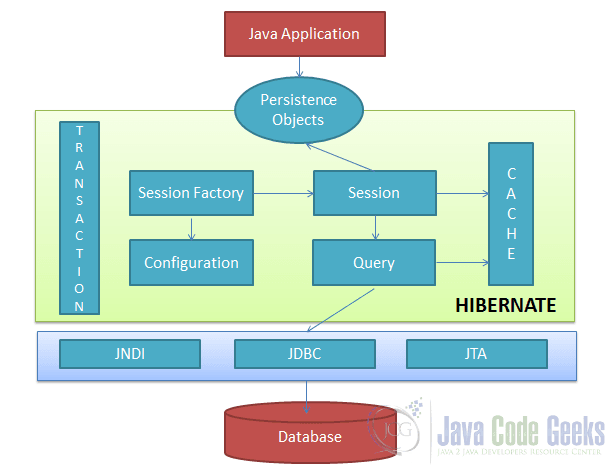What is Hibernate in Java
In this article, we will explore what is Hibernate in Java, through a full tutorial. We are going to learn its features, pros, and cons.
Database integrations are an integral part of enterprise applications. Java provides various ways to interact with databases. The most basic and low-level way is to use JDBC, where we need to write SQL queries. As the applications started growing a need for more sophisticated and easy ways to access, query, and manage data became a need. This gave rise to the invention of Object Relational Mapping frameworks like JPA, MyBatis Hibernate.
1. What is Hibernate?
Hibernate is a Java based Object Relational Mapping framework that provides a way to map Java objects to relational database tables. It is an opensource framework. It implements the JPA (Java Persistence API) specifications for data persistence.
Hibernate Architecture can be dpicted as below:

- Configuration – It is the first object to be created in the Hibernate application and is created only once. It provides the database connection and class mapping structure.
- Session Factory – Thread-safe object and instantiates the
hibernatesessions. The configuration object is the prerequisite. It is a heavy-weight object and normally created during the application startup. - Session – Session is a lightweight object and obtained each time to do database work. Note that the session object isn’t thread-safe.
- Query – Represents SQL or HQL queries to retrieve or modify data. The query object is used to bind the parameters.
- Transaction – A transaction represents a single unit of database work. This is an optional object.
- Cache –
Hibernatesupports query and session-level caches which can elevate the performance substantially - Persistence Object – Persistence objects are the Java objects which map to a relational database table.
2. Why do we need Hibernate
Before the Hibernate ORM, Java programmers had to access the database using JDBC. Programmers often write complex SQL queries and map the result to Java objects programmatically. This made application tightly coupled and made it hard to port the application to a different database as SQL syntaxes vary between the databases.
With ORM and Hibernate’s invention, we can easily map Java objects to database tables either using XML configuration or annotations. This eliminated the whole process of translation and made developers’ life easy. Another notable advantage is database independency. Hibernate abstracts the SQL queries using higher-level Hibernate Query Language, this allows us to write the same queries independent of the database independently.
3. What is JPA?
JPA stands for Java Persistence API. It defines a persistence model for object-relational mapping. This is a Java language specification and it lets us map, store, update, and retrieve from relational databases to Java Objects and vice versa. This is a specification and all different ORMs like Hibernate, EclipseLink and OpenJPA should adhere to this specification.
JPA can be seen as a bridge between Java objects and Relational database tables. Since JPA is specification, it doesn’t do any operations on its own. So it always requires an ORM wich implements it.
4. Hibernate pros and cons
In this section, I am going to discuss some of the advantages and disadvatages of the hibernate famework.
Advatages:
- Hibernate uses its own query language HQL and it lets us write queries in a database-independent manner
- Lets us connect Java Classes to Database tables using XML configuration or using annotation
- Hibernate has the ability to cache the results to optimize the read performance
- It supports transactions, pagination, object versioning and lazy loading of objects
- It supports object inheritance, storing collections to databases
- Along with HQL hibernate ahs support for Native SQL queries as well
Disadvantages:
- Hibernate is slightly less performant compared to JDBC as it has to convert the HQL to its native SQL each time. It runs many SQL queries in the backend based on our object mapping.
- Hibernate doesn’t allow us to insert multiple records into the same table using a single query
- It has some amount of learning curve involved
- Complex data fetches might lead to multiple iterations of the object-to-table mapping
- Debugging and performance tuning could be tricky sometimes
5. Further reading
In this article, we explored what is Hibernate in Java, through a full tutorial. We learned its features, pros, and cons.
We have some more awesome Hibernate articles, some of them are listed below:
- Hibernate configuration Example
- Hibernate Envers Example
- Hibernate Show SQL Example
- Hibernate Inheritance Mapping Example
- Hibernate Many to One Example
- JAX_WS Hibernate Example
- Spring Boot with Hibernate Example
- Spring Vs Hibernate Example
- Hibernate Merge Example
- Spring Rest Hibernate Example
- Spring and Hibernate Example
There are many more Hibernate articles and tutorials on our website. Feel free to go through various articles in your free time.



